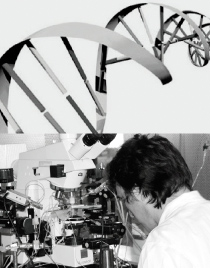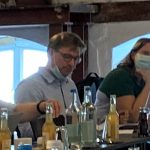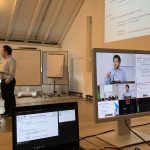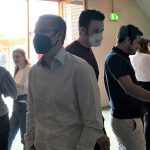After almost 12 years, our transregional Collaborative Research Center CRC TR-128 is coming to an end. To celebrate our achievements and successful collaborations in research of the immune system and multiple sclerosis, we are organizing a final symposium in 2024.
Date: April 29 and 30, 2024
Venue: Castle of the Münster University, Schlossplatz 2, 48149 Münster, Aula
It is our pleasure to join leading experts in the field to discuss the critical balance between initiating/effector and regulatory mechanisms in Multiple Sclerosis, highlighting the progress towards more effective interventions for this chronic inflammatory disease of the central nervous system and will conclude with an outlook on future necessary endeavours. We look forward to sessions covering promising avenues for future research and treatment strategies, informed by insights into the disease’s complex pathology, including inflammation, demyelination, and neurodegeneration, as well as the CNS’s variable repair capacities. For more details, have a look at the program. Registration is possible online until April 15. Please note that hotel accommodation can only be provided for CRC members.
NIC-News
Final Symposium with leading experts in MS
Thu, 28/03/2024
Photo gallery: Inflammation & Imaging Symposium in the MIC building
Thu, 15/09/2022
Muenster. From September 12th to 14th scientists from Muenster University and their international guests discussed the latest developments in research on inflammation and the imaging of the immune system at the 2nd Inflammation & Imaging Symposium. The annual event is jointly organised by several research networks from Münster, among them the CRC/TRR 128 “Multiple Sclerosis”. A photo gallery with impressions from the conference can be found here.
CRC Retreat in Münster
Tue, 28/06/2022
Muenster. After a long pause, more than 90 participants of the CRC joined in Muenster Factory Hotel to update on the latest developments. We heard the most recent on a selection of the CRC projects and there was also plenty of time for fruitful discussion and socializing in the evening.
EU Research Council awards Lydia Sorokin Advanced Grant
Mon, 23/05/2022
 Münster – The biochemist and Principal investigator of the CRC 128 Prof. Dr. Lydia Sorokin has received the coveted “Advanced Grant” awarded by the European Research Council (ERC). The funding of ca. 2.3 million euros enables the realisation of outstanding research projects.
Münster – The biochemist and Principal investigator of the CRC 128 Prof. Dr. Lydia Sorokin has received the coveted “Advanced Grant” awarded by the European Research Council (ERC). The funding of ca. 2.3 million euros enables the realisation of outstanding research projects.
Lydia Sorokin heads the Institute for Physiological Chemistry and Pathobiochemistry at Muenster University. She investigates the extracellular matrix (ECM) of blood vessels, especially those of the brain. These vessels are impermeable to cells, toxins, and pathogens and are part of the blood-brain barrier (BBB). One of Lydia Sorokin’s most important projects deals with multiple sclerosis and the question of how leukocytes penetrate the brain via the BBB in this disease, thereby causing disease symptoms. The focus is on a particular space discovered by the Sorokin team that surrounds the cerebral blood vessels and is formed by structures of the ECM. This is a favourite residence of leukocytes before they enter the brain in inflammatory brain diseases. The aim of the ERC grant-funded project is to investigate the molecular processes that are required to maintain the BBB, but allow immune cells to penetrate this barrier. To this end, Lydia Sorokin and her team want to reproduce the essential components of the BBB in vitro in three dimensions. Combined with studies on genetically modified mice, the researchers want to find out how the leukocytes manage to penetrate the brain in inflammatory diseases. The replication of the BBB in the laboratory will allow for testing of different substances in order to develop novel drugs against inflammation or tumours in the brain.
The “Advanced Grants” funding line is aimed at established scientists, who have produced outstanding scientific work over the past ten years.
Dietary conjugated linoleic acid links reduced intestinal inflammation to amelioration of CNS autoimmunity
Mon, 09/08/2021
A close interaction between gut immune responses and distant organ-specific autoimmunity including the CNS in multiple sclerosis has been established in recent years. This so-called gut-CNS axis can be shaped by dietary factors, either directly or via indirect modulation of the gut microbiome and its metabolites. Here, SFB 128 PI Luisa Klotz and colleagues report that dietary supplementation with conjugated linoleic acid, a mixture of linoleic acid isomers, ameliorates CNS autoimmunity in a spontaneous mouse model of multiple sclerosis, accompanied by an attenuation of intestinal barrier dysfunction and inflammation as well as an increase in intestinal myeloid-derived suppressor-like cells. More . . .
BioNTech Publishes Data on Novel mRNA Vaccine Approach to Treat Autoimmune Diseases in Science
Thu, 28/01/2021
BioNTech SE (Nasdaq: BNTX, “BioNTech” or “the Company”) announced the publication of preclinical data on its novel mRNA vaccine approach against autoimmune diseases in the peer-reviewed journal Science. The publication titled “A non-inflammatory mRNA vaccine for treatment of experimental autoimmune encephalomyelitis” co-authored by SFB principal investigator Ari Waisman summarizes the findings on the disease-suppressing effects of a non-inflammatory, nucleoside-modified mRNA vaccine in several clinically relevant mouse models of multiple sclerosis (MS). More . . .
A new study on neurological manifestations of severe COVID-19 reveals nervous system immune deficiency
Wed, 20/01/2021
Patients suffering from COVID-19 can develop concomitant and long-term symptoms in their nervous system. The most common symptom in this context is the loss of the sense of smell and taste, while more severe symptoms such as stroke, cerebral seizures, or meningitis are possible. A team of scientists from the medical faculties at the Universities of Münster and Duisburg-Essen investigated this phenomenon, termed Neuro-COVID. They could demonstrate that immune and interferon responses are weakened in COVID-19 patients. These results were recently published in the journal Immunity.
The research teams applied state-of-the-art single-cell transcription technologies, which help visualize the expression of thousands of genes on a single-cell level. “This allowed us to characterize in detail the immune response of Neuro-COVID in the cerebral fluid at a location near the brain”, says PD Dr. Gerd Meyer zu Hörste, a senior physician in the Department of Neurology at the University Hospital Münster and senior author of the study publication. “From a group of 102 COVID-19 patients, we identified those who developed neurological symptoms and required a cerebral fluid extraction for further diagnosis”, says PD Dr. Dr. Mark Stettner, who is a senior physician in the Depart

Priv.-Doz. Dr-Gerd Meyer zu Hörste (left) and Dr. Michael Heming investigated “Neuro-Covid”.
ment of Neurology at the University Hospital Essen and led the study together with Meyer zu Hörste.
Samples from eight Neuro-COVID patients were collected and sent to Münster for analysis. “An increased number of T cells in the patients’ cerebral fluid had reached a stage of exhaustion”, says Dr. Michael Heming, first author of the study and assistant physician in the Department of Neurology at the University Hospital Münster. Also, the interferon answer of Neuro-COVID patients was reduced compared with viral brain inflammation. Interferons are an essential early defense mechanism for viral diseases. The researchers further found an increased number of dedifferentiated phagocytes in the cerebral fluid.
“These findings indicate a reduced antiviral immune response in Neuro-COVID patients”, says Prof. Christoph Kleinschnitz, Director of the Department of Neurology at the University Hospital Essen. A more detailed understanding of the Neuro-COVID phenomenon is the basis for faster disease detection and improved treatment. “Publication of the study results in a high-class journal such as Immunity is the result of intensive and hard work. Our researchers achieved impressive results within a short time”, says Prof. Wiendl, Director of the Department of Neurology at the University Hospital Münster.
Sunlight exposure exerts immunomodulatory effects to reduce multiple sclerosis severity
Fri, 15/01/2021
It has long been acknowledged that multiple sclerosis disease risk is associated with reduced sun-exposure, and subsequent low vitamin D levels. The study by Ostkamp et al. now assessed the relationship between measures of sun exposure and MS severity. For this, the researchers analyzed data of around 2,000 patients from the German NationMS- and the French BIONAT cohort. To approximate a patients’ sunlight exposure, the researchers used serum vitamin D measurements, the geographical latitude of residence, and UV-light estimates extracted from the recordings of NASA satellites. As expected, high serum vitamin D could be shown to be associated with a reduced MS severity score, reduced risk for relapses, and lower disability accumulation over time. Furthermore, low latitude associated with higher vitamin D levels, a lower MS severity score, fewer gadolinium-enhancing lesions, and lower disability accumulation over time. As an exception, no association between latitude and disability was found in patients who were treated with IFN-β before the start of the study. This lined up with a finding from an RNA-sequencing analysis, in which the researchers could show an induction of the type I interferon-pathway in a small cohort of patients, who were treated with narrowband UVB-light for six weeks.

Patrick Ostkamp was in the team of scientists who analysed the cohort data. (Photo: Leßmann)
Therefore, as UVB potentially initiates an interferon response itself, it might be possible that no effect of UVB can be observed in patients whose blood is already saturated with interferons. Although the study shows that sunlight exposure has a beneficial effect on MS severity, the researchers argue against excessive sun exposure, as the observed effects of UV-light were of comparably low magnitude, and photosensitive patients who carried a genetic variant of the melanocortin-1-receptor (an important factor for pigmentation) even seemed to worsen upon increased sunlight exposure, according their MRI activity.
Reference: Ostkamp P, Salmen A, Pignolet B, Görlich D, Andlauer TFM, Schulte-Mecklenbeck A, Gonzalez-Escamilla G, Bucciarelli F, Gennero I, Breuer J, Antony G, Schneider-Hohendorf T, Mykicki N, Bayas A, Then Bergh F, Bittner S, Hartung H-P, Friese MA, Linker RA, Luessi F, Lehmann-Horn K, Mühlau M, Paul F, Stangel M, Tackenberg B, Tumani H, Warnke C, Weber F, Wildemann B, Zettl UK, Ziemann U, Müller-Myhsok B, Kümpfel T, Klotz L, Meuth SG, Zipp F, Hemmer B, Hohlfeld R, Brassat D, Gold R, Gross CC, Lukas C, Groppa S, Loser K, Wiendl H, Schwab N, German Competence Network Multiple Sclerosis (KKNMS) and the BIONAT Network. 2021. Sunlight exposure exerts immunomodulatory effects to reduce multiple sclerosis severity. Proc Natl Acad Sci U S A. 118(1):e2018457118.
Transregio-Cooperative Research Centre „Multiple Sclerosis“ funded for another four years
Tue, 15/12/2020
The Collaborative Research Center 128 “Multiple Sclerosis” is entering its third round. As the German Research Association announced, the major project with locations in Münster, Mainz and Munich will be supported for a further four years (until mid-2024). Speaker Prof. Heinz Wiendl, Co-Spokesperson Prof. Frauke Zipp (Mainz) and other scientists are researching multiple sclerosis – a chronic inflammatory and neurodegenerative disease of the central nervous system. Their focus is on the interaction between the immune and nervous systems on a molecular, cellular and systems biological level. The 35 principal investigators and their teams analyse the changes in the immune system underlying the disease, effects the attack of the immune system has on the central nervous system and how these consequences can be modulated with the latest therapies. The 22 individual projects are tackling a wide range of topics, including the role of the intestinal microbiome in inflammation and nerve destruction in MS, the patterns of nerve damage that MS patients e.g. in MRI images show and the effect of various MS drugs on the immune system. In the next four years, the focus of her work will be on coping with illnesses. This means both better control and monitoring of the now widespread drugs for treating MS and translation – i.e. the transfer of research results into patient care and – the other way around – the use of knowledge from clinical practice for work in the laboratory.
Dr. Beatrice Wasser awarded DGfI Herbert Fischer Prize for Neuroimmunology
Tue, 06/10/2020
 Each year, the German Society for Immunology (DGfI) recognizes young scientists who have made an outstanding contribution in the field of immunology. This year, Dr. Beatrice Wasser, a Postdoc in the group of Prof. Frauke Zipp and Prof. Stefan Bittner in the Department of Neurology, was award the Herbert Fischer Prize for Neuroimmunology for her investigation of the mechanism by which cells of the central nervous system (CNS) can control autoreactive T lymphocytes. Dr. Wasser was able to show, for the first time, that myeloid cells in the CNS can trap and kill invading pathogenic T cells. This novel defense pathway could potentially be exploited, leading to a new therapy for T cell-induced autoimmune diseases such as multiple sclerosis.
Each year, the German Society for Immunology (DGfI) recognizes young scientists who have made an outstanding contribution in the field of immunology. This year, Dr. Beatrice Wasser, a Postdoc in the group of Prof. Frauke Zipp and Prof. Stefan Bittner in the Department of Neurology, was award the Herbert Fischer Prize for Neuroimmunology for her investigation of the mechanism by which cells of the central nervous system (CNS) can control autoreactive T lymphocytes. Dr. Wasser was able to show, for the first time, that myeloid cells in the CNS can trap and kill invading pathogenic T cells. This novel defense pathway could potentially be exploited, leading to a new therapy for T cell-induced autoimmune diseases such as multiple sclerosis.
This work was recently published in the Journal of Experimental Medicine:
Wasser B, Luchtman D, Löffel J, Robohm K, Birkner K, Stroh A, Vogelaar CF, Zipp F, Bittner S. CNS-localized myeloid cells capture living invading T cells during neuroinflammation. J Exp Med 2020; 217(6): e20190812.
The official press release of the DGfI is available here.
Study with identical twins shows that the early form of multiple sclerosis has a specific pattern
Tue, 08/09/2020

Happy about the new findings from the MS-TWIN study: PhD student Claudia Janoschka (right) and group leader Prof. Luise Klotz (Photo: Deiters-Keul)
The tremendous heterogeneity of the human population presents a major obstacle in understanding how autoimmune diseases like multiple sclerosis (MS) contribute to variations in human peripheral immune signatures. To minimize heterogeneity, SFB researchers from Munich and Muenster made use of a unique cohort of 43 monozygotic twin pairs clinically discordant for MS and searched for disease-related peripheral immune signatures in a systems biology approach covering a broad range of adaptive and innate immune populations on the protein level. Results of their work were published in the latest issue of the prestigious journal PNAS.
Despite disease discordance, the immune signatures of MS-affected and unaffected cotwins were remarkably similar. Twinship alone contributed 56% of the immune variation, whereas MS explained 1 to 2% of the immune variance. Notably, distinct traits in CD4+ effector T cell subsets emerged when Lisa Ann Gerdes, Claudia Janoschka and colleagues focused on a subgroup of twins with signs of subclinical, prodromal MS in the clinically healthy cotwin. Some of these early-disease immune traits were confirmed in a second independent cohort of untreated early relapsing-remitting MS patients. Early involvement of effector T cell subsets thus points to a key role of T cells in MS disease initiation.
Adapted from.
Gerdes LA° Janoschka C°, Eveslage M, Mannig B, Wirth T, Schulte-Mecklenbeck A, Lauks S, Glau L, Gross CC, Tolosa E, Flierl-Hecht A, Ertl-Wagner B, Barkhof F, Meuth SG, Kümpfel T, Wiendl H°, Hohlfeld R*, Klotz L*. Immune signatures of prodromal multiple sclerosis in monozygotic twins. Proc Natl Acad Sci U S A 117(35):21546-21556. (°,*= equal contribution)
Breakthrough: SFB scientsists explain pathomechanism of Susac Syndrome
Mon, 09/03/2020

SFB researchers Dr. Catharina Groß, Prof. Dr. Heinz Wiendl and their team have deciphered important processes in Susac syndrome (Photo: Monecke)
Neuroinflammation is often associated with blood-brain-barrier dysfunction, which contributes to neurological tissue damage. In a paper published in the renowned journal Nature Communications SFB 128 scientists from Mueenster reveal the pathophysiology of Susac syndrome (SuS), an enigmatic neuroinflammatory disease with central nervous system (CNS) endotheliopathy. By investigating immune cells from the blood, cerebrospinal fluid, and CNS of SuS patients, Dr. Catharina Gross and her team demonstrate oligoclonal expansion of terminally differentiated activated cytotoxic CD8+ T cells (CTLs). Neuropathological data derived from both SuS patients and a newly-developed transgenic mouse model recapitulating the disease indicate that CTLs adhere to CNS microvessels in distinct areas and polarize granzyme B, which most likely results in the observed endothelial cell injury and microhemorrhages. The autors show that blocking T-cell adhesion by anti-α4 integrin-intervention ameliorates the disease in the preclinical model. Similarly, disease severity decreases in four SuS patients treated with natalizumab along with other therapy. Their study identifies CD8+ T-cell-mediated endotheliopathy as a key disease mechanism in SuS and highlights therapeutic opportunities.
Adapted from: Gross CC, Meyer C, Bhatia U, Yshii L, Kleffner I, Bauer J, Tröscher AR, Schulte-Mecklenbeck A, Herich S, Schneider-Hohendorf T, Plate H, Kuhlmann T, Schwaninger M, Brück W, Pawlitzki M, Laplaud DA, Loussouarn D, Parratt J, Barnett M, Buckland ME, Hardy TA, Reddel SW, Ringelstein M, Dörr J, Wildemann B, Kraemer M, Lassmann H, Höftberger R, Beltrán E, Dornmair K, Schwab N, Klotz L, Meuth SG, Martin-Blondel G, Wiendl H, Liblau R. CD8+ T cell-mediated endotheliopathy is a targetable mechanism of neuro-inflammation in Susac syndrome. Nat Commun. 2019 Dec 18;10(1):5779.
The brain is less immune-priviledged than we thought
Wed, 04/03/2020
Münster. Although the CNS is immune privileged, continuous search for pathogens and tumours by immune cells within the CNS is indispensable. Thus, distinct immune-cell populations also cross the blood–brain barrier independently of inflammation/under homeostatic conditions. It was previously shown that effector memory T cells populate healthy CNS parenchyma in humans and, independently, that CCR5-expressing lymphocytes as well as CCR5 ligands are enriched in the CNS of patients with multiple sclerosis. Apart from the recently described CD8+ CNS tissue-resident memory T cells, CRC researchers from Muenster identified a population of CD4+CCR5high effector memory cells as brain parenchyma-surveilling cells. In an interview with the German radio news channel NDR info they explain these latest insights. Listen to the radio report (in German):
Adapted from: Herich S, Schneider-Hohendorf T, Rohlmann A, Khaleghi Ghadiri M, Schulte-Mecklenbeck A, Zondler L, Janoschka C, Ostkamp P, Richter J, Breuer J, Dimitrov S, Rammensee HG, Grauer OM, Klotz L, Gross CC, Stummer W, Missler M, Zarbock A, Vestweber D, Wiendl H, Schwab N. Human CCR5high effector memory cells perform CNS parenchymal immune surveillance via GZMK-mediated transendothelial diapedesis. Brain.142(11):3411-3427.
Featured Publication: Integrated single cell analysis of blood and cerebrospinal fluid leukocytes in multiple sclerosis
Mon, 27/01/2020
Münster. Cerebrospinal fluid (CSF) protects the central nervous system (CNS) and analyzing CSF aids the diagnosis of CNS diseases, but our understanding of CSF leukocytes remains superficial. Here, using single cell transcriptomics, SFB researchers identify a specific border-associated composition and transcriptome of CSF leukocytes. In an article published in Nature Communications, they show that multiple sclerosis (MS) – an autoimmune disease of the CNS – increases transcriptional diversity in blood, but increases cell type diversity in CSF including a higher abundance of cytotoxic phenotype T helper cells. A new analytical approach, named cell set enrichment analysis (CSEA) identifies a cluster-independent increase of follicular T helper (TFH) cells potentially driving the known expansion of B lineage cells in the CSF in MS. In mice, TFH cells accordingly promote B cell infiltration into the CNS and the severity of MS animal models. Immune mechanisms in MS are thus highly compartmentalized and indicate ongoing local T/B cell interaction.
Schafflick D, Xu CA, Hartlehnert M, Cole M, Schulte-Mecklenbeck A, Lautwein T, Wolbert J, Heming M, Meuth SG, Kuhlmann T, Gross CC, Wiendl H, Yosef N, Meyer Zu Horste G . 2020. Integrated single cell analysis of blood and cerebrospinal fluid leukocytes in multiple sclerosis. Nat Commun 11(1):247.
The key lies in cell metabolism: Neuroscientist and neurologist Luisa Klotz wins renowned Heinrich-Pette-Award
Tue, 22/10/2019

92. Congress of the German Society of Neurology in Stuttgart Foto: Claudius Pflug
Münster. For the third time the renowned neuroscience award “Heinrich Pette prize” goes to Münster, as this year Luisa Klotz was rewarded with the prestigious award for neuroscience researchers and clinicians at the congress of the German Society of Neurology in Stuttgart.
Neurologist and Neuroscientist Luisa Klotz received the award for her outstanding research in the field of Multiple Sclerosis and related neuroinflammatory disorders. She succeeds the director of the department of neurology Prof. Heinz Wiendl (2009) and the director of the institute of translational neurology Prof. Sven Meuth (2014). Read more . . .
Publication: Teriflunomide treatment for multiple sclerosis modulates T cell mitochondrial respiration with affinity-dependent effects.
Mon, 03/06/2019
Muenster. For the first time scientists from the University of Münster could show that multiple sclerosis (MS) alters the energy metabolism of T cells during acute phases of disease exacerbation. Therapeutic interventions targeting the metabolism of activated T cells display new potential avenues for treatment of patients with MS affecting around 250,000 people in Germany. The results of the study have recently been published in the renowned journal Science Translational Medicine. In a clinical trial, the authors investigated the effects of the MS drug teriflunomide in patients and analyzed its effects on immune cells. They could reveal that the drug specifically interferes with the energy metabolism of T cells and thereby preferentially affects highly active immune cells. “The drug specifically interferes with the activation of these cells already in the early initiation phase”, explains Luisa Klotz, first author of the article and principal investigator at the DFG-funded collaborative research centre 128 “Multiple Sclerosis”. Science Translational Medicine doi: 10.1126/ scitranslmed. aao5563.
Publication: Calcium influx through plasma-membrane nanoruptures drives axon degeneration in a model of multiple sclerosis.
Mon, 29/04/2019
Munich. Here SFB researchers from Munich use in vivo calcium imaging in a multiple sclerosis model to show that cytoplasmic calcium levels determine the choice between axon loss and survival. Calcium can enter the axon through nanoscale ruptures of the axonal plasma membrane that are induced in inflammatory lesions. Neuron doi: 10.1016/ j.neuron.2018.12.023
Featured publication: Low-Frequency and Rare-Coding Variation Contributes to Multiple Sclerosis Risk
Fri, 26/10/2018
In a large multi-cohort study, performed by the International Multiple Sclerosis Genetics Consortium (IMSGC) and published in Cell Magazine, unexplained heritability for multiple sclerosis (MS) is detected in low-frequency coding variants that are missed by genome-wide association study (GWAS) analyses, further underscoring the role of immune genes in MS pathology. The IMSGC was formed in 2003 with funding from the National Multiple Sclerosis Society and published results from the first GWAS in 2007 that identified the second and third susceptibility genes known to predispose people to developing MS. IMSGC later expanded to include more research groups from more countries, receiving grants to conduct larger GWAS studies. IMSGC brings together researchers from 15 different countries, among them scientists from the SFB-CRC 128 member organizations Technische Universität München and Universitätsmedizin Mainz. A pdf of the article may be found here (restricted access)
Munich Cluster for Systems Neurology (SyNergy) will be funded
Tue, 09/10/2018
Munich. The Cluster for Systems Neurology (SyNergy) by LMU and TUM will receive funding from 2019 on. Currently SFB PIs Prof. Reinhard Hohlfeld, Prof. Martin Kerschensteiner, Prof. Mikael Simons are also PIs of SyNergy projects.
Roland Liblau: “Immune targeting of CNS neurons” – Video available
Mon, 05/02/2018
Münster. On January 31, Prof. Roland Liblau, Director of the Pathophysiology Research Center at Toulouse Purpan, gave a lecture on “Immune targeting of CNS neurons: from mouse models to human diseases”. Prof. Liblau is one of the most visible neuroimmunologists worldwide which is why the SFB 128 is proud to make his lecture also available online. Just click here to see his presentation.
Elisabeth Schuh received SEED funding
Thu, 09/11/2017
 Munich. SFB 128 researcher Elisabeth Schuh, MD, has been honoured by a young scientist’s studentship within the KKNMS SEED program. In her project „The role of the NLRP3 inflammasome in multiple sclerosis and experimental autoimmune encephalomyelitis“, Dr. Schuh analyses the influence of the NLRP3in MS. NLRP is a cytosolic protein complex in monocytes, macrophages and neutrophil granolucytes that regulated the production of inflammatory cytokines of the interleukin-1 family. In her project, Dr. Schuh wants to identify the population of myeloid cells involved in MS pathogenesis, with the aim of finding new pathways for therapeutic intervention that prevent autoimmune tissue damage.
Munich. SFB 128 researcher Elisabeth Schuh, MD, has been honoured by a young scientist’s studentship within the KKNMS SEED program. In her project „The role of the NLRP3 inflammasome in multiple sclerosis and experimental autoimmune encephalomyelitis“, Dr. Schuh analyses the influence of the NLRP3in MS. NLRP is a cytosolic protein complex in monocytes, macrophages and neutrophil granolucytes that regulated the production of inflammatory cytokines of the interleukin-1 family. In her project, Dr. Schuh wants to identify the population of myeloid cells involved in MS pathogenesis, with the aim of finding new pathways for therapeutic intervention that prevent autoimmune tissue damage.
The SEED program addresses scientists younger than 32 years who have not yet completed their medical training. The maximum funding is 32.000 € or 75 percent of the project’s budget. The remaining 25% have to be paid by the stipend’s employee.
Three new CRC associates
Tue, 17/10/2017
Muenster / Mainz / Munich. The CRC is proud to welcome three scientists as new associates: Muthuraman Muthuraman (Mainz), Anneli Peters (LMU) and Gerd Meyer zu Hörste (Münster).
All three are reputable neuroimmunologists, who add their in-depth knowledge of techniques and concepts to the existing team. Dr. Muthuraman Muthuraman is head of the scientific working group on biomedical statistics and multimodal signal processing at the Department of Neurology in Mainz (head: Prof. Frauke Zipp). Dr. Anneli Peters is project leader at the working group of Emeritus Director Prof. Hartmut Wekerle, focusing on the pathogenesis of multiple sclerosis. Dr. Gerd Meyer zu Hörste heads a scientific working group on understanding the interaction between nervous and immune system at the Department of Neurology in Muenster (head: Prof. Heinz Wiendl).
Genetically altered mice provide initial evidence that human gut bacteria can trigger multiple sclerosis
Tue, 12/09/2017
Munich. (LMU) Multiple sclerosis (MS) is the most common inflammatory disease of the central nervous system. There are many indications that MS is an autoimmune disease in which immune cells “accidentally” attack the brain and spinal cord. However, as with other autoimmune diseases, the actual triggers of the autoimmune reaction are still unknown. A new study by scientists from the SFB 128 demonstrated for the first time that gut bacteria of MS patients are able to trigger an MS-like disease in an animal model. More . . .
Prof. Stefan Bittner receives Hertie Foundation medMS MyLab Research Funding
Mon, 11/09/2017
Mainz. Prof. Stefan Bittner joins fellow SFB 128 researcher Klaus Lehmann-Horn as the second 2017 recipient of research funding from the Hertie Foundation within the „MyLab” framework. Prof. Stefan Bittner will be funded by the program medMS My Lab to execute a new multi-year research project whose goal is to examine new mechanisms involved in neuronal degeneration in multiple sclerosis. More . . .
SFB researcher acquired Hertie foundation funding
Sun, 10/09/2017
Munich. SFB CRC 128 researcher Dr. Klaus Lehmann-Horn, Department of Neurology, has acquired 396.000€ of funding as part of the framework „MyLab“, which is sponsored by the Hertie foundation. The duration of the project „Antigen-driven affinity maturation of B lymphocytes in meningeal ectopic lymphoid tissue in a model of Multiple Sclerosis“ will be 5 years, starting on January 1st.
Visualizing context-dependent calcium signaling in encephalitogenic T cells in vivo by two-photon microscopy
Sat, 01/07/2017
Munich. In a recently published PNAS paper we visualized intracellular calcium in the encephalitogenic T cells in vivo by using FRET based sensor. The T cells showed short and long lasting calcium signaling dependent on their interaction partners. The blocking of the calcium signaling can be used as target of therapeutic treatments . More . . .
SFB researcher wrote paper of the month
Thu, 04/05/2017
Muenster. The article “Rapid and efficient generation of oligodendrocytes from human induced pluripotent stem cells using transcription factors” by SFB researcher Marc Ehrlich has been named “paper o the month” of May by the Medical Faculty Muenster. With this award the faculty honors excellent examples for the continuous output of its about 2.000 scientisits.
SFB Scientists reprogram skin cells to brain cells to facilitate neurological research
Thu, 16/03/2017

SFB scientists Prof. Tanja Kuhlmann und Dr. Marc Ehrlich generate oligodendrocytes from skin cells (photo: FZ/E. Deiters-Keul)
Münster. (mfm/jr) Whether it be math, writing, reading or learning a new language: brain cells give us astonishing brainpower every day. When these cells are damaged by neurological diseases, cells cannot be simply sampled and analyzed in a petri dish. Scientists from the University of Münster and the Max Planck Institute for Molecular Biomedicine developed a new protocol to generate their brain cells of interest, oligodendrocytes, from skin. The team in Münster belongs to the few labs worldwide that have established this technique successfully in their lab; however the team in Münster can do this now much faster and more efficiently – with significant benefit for research. More . . .
Research into “accident black spots“: new hypothesis on the origins of centres of inflammation in multiple sclerosis
Mon, 21/11/2016
Münster (mfm/sk-sm) – The scenario resembles a serious motor accident: a car has spun out of control, breaches the central crash barrier and collides with the oncoming traffic. In the case of multiple sclerosis, harmful T-cells break through the protective blood-brain barrier and thus penetrate into the central nervous system (CNS), where they trigger a destructive inflammation. What’s special about this is that evidently the CNS also has “accident black spots” – in other words, places where an especially high number of centres of inflammation are be found. Neuro-immunologists at Münster University have now found out why this is so. More . . .

PD Dr. Luisa Klotz and Ivan Kuzmanov at work in the laboratory (Photo: FZ/UKM)
Milestone in MS research: neuroimmunologists find cause of deficit in body’s own immune system
Tue, 25/10/2016
Within a project of the SFB 128, scientists from the universities in Münster and Munich have discovered what precisely goes wrong in the body in the case of multiple sclerosis (MS). At the same time the neuroscientists were able to demonstrate that for MS, which occurs in bouts, there is a therapy which is tailor-made to eliminate the deficit. More Information . . .
Stipend for International Cooperation with Turkey (Project B08)
Fri, 04/03/2016
Dr. Atay Vural has been awarded a stipend by the Alexander von Humboldt Foundation to spend time in the group of Prof. Edgar Meinl to conduct research into MOG-Ak, which is part of the work done in the CRC-TR128 B08 project. After Dr. Vural’s stay in Prof. Meinl’s group, he will return to his home country of Turkey, where he will employ the techniques learnt in Germany in further research projects.
Two young researchers from CRC TR128 awarded Helmut Bauer Prize 2015
Fri, 04/03/2016
Sarah Laurent und Franziska Thaler, scientists working on the B08 project of the CRC TR128, have been awarded the Helmut Bauer Prize 2015 for young researchers for their work on the survival, regulation and activation of B cells in multiple sclerosis (see publications below). More information on this prize can be found in this press release (in German).
Laurent et al. γ-Secretase directly sheds the survival receptor BCMA from plasma cells Nat Commun 2015 6:7333
Hoffmann et al. The immunoregulator soluble TACI is released by ADAM10 and reflects B cell activation in autoimmunity J Immunol 2015 194(2):542-52
Heinz Wiendl awarded Sobek Prize for MS research
Wed, 27/01/2016
Prof. Heinz Wiendl, Co-Speaker of the CRC-TR-128, has been awarded the prestigious Sobek Research Prize 2015 for his contributions to research into multiple sclerosis. More information can be found in this press release (in German)
CRC Principal Investigator, Prof. Jacqueline Trotter, together with Prof. Thomas Mittmann, discuss the role of glial cells in neuronal signalling on Deutschland Funk radio
Thu, 04/06/2015
You can read the associated article and listen to the interview on the Deutschland Funk website or using the player below.
Nina Wettschureck awarded prize for mechanistic elucidation of MS therapy
Tue, 21/04/2015
Nina Wettschureck (MPI Bad Nauheim) from the CRC-TR-128, together with Markus Schwaninger (University of Lübeck), has been awarded the Novartis prize for therapy-relevant pharmacological research. The prize, which carries a value of €10,000, was presented at the Annual Conference of the German Society for Experimental and Clinical Pharmacology and Toxicology (DGPT) on 12 March 2015 in Kiel.
More details can be found in this press release, and the research for which the prize was awarded was reported in the following publication in The Journal of Clinical Investigation:
CRC scientists Nicholas Schwab and Johanna Breuer win Helmut-Bauer Young-Scientist Prize for MS research
Mon, 02/02/2015
Congratulations to the CRC Scientists Nicholas Schwab and Johanna Breuer from the Neurological Clinic of the University Hospital Münster who were awarded the Helmut-Bauer Young-Scientist Prize for MS Research. (more…)
CRC scientists discover new protection mechanism for nerve cells after they are damaged
Thu, 22/01/2015
CRC scientists from the University Medical Center Mainz, together with colleagues from the University of Virginia, have identified a new mechanism that mediates repair of nerve cells after damage to the central nervous system. (more…)
International Neuroimmunology Conference in Mainz
Fri, 05/12/2014
From 9-13 November 2014, over 1000 neuroimmunologists from all over the world met at the 12th International Congress for Neuroimmunology in Mainz. (more…)
CRC Young Researchers win prizes at prestigious conferences
Fri, 26/09/2014
Congratulations to Dr. Nicholas Schwab and Dr. Tilman Schneider-Hohendorf, both from the Department of Neurology, University of Münster, who received prizes at two prestigious conferences recently! (more…)
How adhesion molecules help pathogenic T cells to find their way over the blood-brain-barrier
Tue, 16/09/2014
Münster scientists: Even a highly efficacious MS drug cannot stop certain inflammatory cells (more…)
CRC Scientist Krishnaraj Rajalingam becomes Heisenberg Professor for Cell Biology in Mainz
Mon, 21/07/2014
Congratulations to Krishnaraj Rajalingam (Project B9) who has received a prestigious Heisenberg Professorship for cell biology at the Institute for Immunology of the University Medical Center of the Johannes Gutenberg University Mainz. This is the first such professorship for the JG University of Mainz. Further details can be found here.
CRC Retreat in Munich
Fri, 23/05/2014
Thanks to all those who attended the CRC Retreat in Munich in May. As well as having great weather, there were also excellent scientific talks and lively discussion during the poster session and in the Biergarten afterwards.
Special thanks go to the organizer Jutta Marks, who did a fantastic job in making this such an enjoyable meeting for all concerned.
Münster: Scientists demonstrate the influence of sunlight exposure on the incidence of autoimmune diseases
Thu, 15/05/2014
Skills Workshop in Frankfurt
Fri, 20/12/2013
Thank you to all those who attended the skills workshop “Career Options in Academia and Beyond” on 18.12.2013 in Frankfurt. (more…)
CRC Retreat in Münster
Thu, 12/12/2013
Thank you to all who attended the CRC Retreat in Münster on 28-29.11.2013. It provided a great opportunity for CRC members to meet and be updated on the progress of all research projects with lively poster sessions, interesting talks and stimulating discussion. (more…)
Videoconference of Prof. Gold’s talk
Thu, 12/12/2013
Thanks to all who participated in the videoconference of Prof. Gold’s talk in Mainz on 10.12.2013. (more…)
Successful videoconference of Prof. Wekerle’s talk
Fri, 22/11/2013
On Thursday 21.11.2013, we successfully used our new videoconferencing equipment here in Mainz to watch Prof. Hartmut Wekerle give a very interesting talk in München. Thanks to all those who helped to make this technically possible. (more…)
Nature Medicine paper from Münster research groups
Fri, 16/08/2013
Bittner et al’s paper entitled Endothelial TWIK-related potassium channel-1 (TREK1) regulates immune-cell trafficking into the CNS published in Nature Medicine is now available to be viewed here.
Neurosymposium
Thu, 08/11/2012
08.11.2012, 13:30: Neurosymposium:The Cell Biology of CNS Development, Myelination and Multiple Sclerosi, @ Johannes Joachim Becherweg 13, HS19, Mainz






























